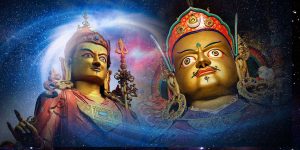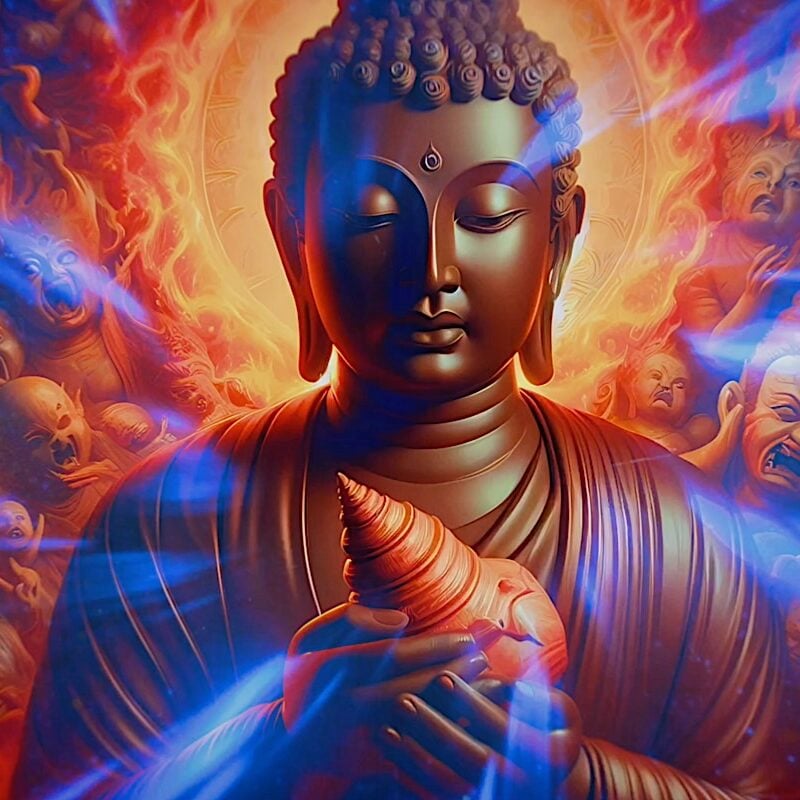June 4 this year is SAGA DAWA DUCHEN — celebrating Shakyamuni Buddha’s Enlightenment and Paranirvana! May All Beings Benefit!
SAGA DAWA DUCHEN is the day in Tibetan Tradition that we celebrate Buddha’s birth, enlightenment, and paranirvana on the Tibetan Lunar Calendar (converted this year to June 4, 2023).
Saga Dawa Duchen is a day of highest merits — may all beings benefit! Every positive karma activity is multiplied many times on this most sacred of days according to sacred texts.

How important is Saga Dawa Duchen?
Lama Zopa Rinpoche explains, on the FPMT website:
“Saka Dawa Duchen is one of the four great holy days of the Tibetan calendar, each of which celebrates an anniversary of Shakyamuni Buddha’s display of extraordinary powerful deeds for sentient beings’ sake. On these four days, karmic results are multiplied by 100 million, as taught in the Vinaya text Treasure of Quotations and Logic.”
NOTE: This is often confused with Vesak, which is on a separate lunar calendar. Saga Dawa celebrates on the Tibetan Lunar Calendar. For more about lunar calendars, see our full feature “Clearing the Confusion on Lunar Calendars”>>
Most Important Day of the Year!
The most important month in the Tibetan lunar calendar is Saga Dawa, the 4th lunar month which runs from May 20 to June 18th 2023, with the biggest celebration on the full moon, June 4, 2023. (Full moon is also a day for taking Precepts and Medicine Buddha and Green Tara pujas)
The 15th day of this lunar month, the full moon day is called Saga Dawa Düchen (Düchen means “great occasion”) — the most important day in the Buddhist calendar, this year on June 4, 2023 (on the western solar-based calendar).
Saga Dawa Düchen commemorates the Birth, Enlightenment, and Paranirvana of our Perfect and most Supreme teacher, Buddha Shakyamuni. In other Buddhist traditions, this occasion is known as Buddha Purnima, or Buddha Day — and may be celebrated slightly earlier than Saga Dawa, depending on the tradition.
From FPMT site: “it is a day when karmic results are multiplied by 300 million times as it commemorates Shakyamuni Buddha’s three major life events.”

Saga Dawa Duchen
The most important day in the month (perhaps for the entire year, for many Buddhists) is Saga Dawa Duchen on the full moon. Duchen means “great occasion,” and this year falls on the full moon day, June 14. It is similar to Vesak in Theravadin Buddhism — celebrating the birth, Enlightenment and Paranirvana of Shakyamuni Buddha, but is based on the Tibetan lunar calendar. Both are the “4th month” of the lunar calendars, but they are calculated differently. (See this feature on lunar confusion for clarification>>)
The day of the “Great Occasion” this year on June 4, 2023 is the best day of the entire year for “making merit” for the benefit of all sentient beings. In addition to the 8 precepts, other activities recommended include:
- Strongly recommended by Lama Zopa: do a Shakyamuni Buddha Puja. There are long and short forms of this Puja, downloadable here from FPMT>>
- Reciting the Sutra Remembering the Three Jewels [For a feature on the benefits of reciting sutra out loud, see this special story>>]
- Your regular daily practices.
- Reciting sutras, such as Vajra Cutter Sutra, Sutra of Golden Light, and Sanghata Sutra
- Reciting other prayers, such as Chanting the Names of Manjushri, and King of Prayers
- Undertaking Nyung nes
- Performing self-initiation, for those who fulfilled the necessary prerequisites (normally only for people who have completed a particular retreat protocol and fire puja.)
- Performing Lama Chopa, and at either the beginning of the practice or during the lamrim section, you can meditate on emptiness
- Reciting the names of the Thirty-Five Buddhas, with prostrations
- Reciting Vajrasattva mantras
- Reciting OṂ MAṆI PADME HŪṂ with bodhichitta
- Meditating on emptiness and dependent arising
- Meditating on bodhichitta
- Practicing tonglen
- Rejoicing
- Liberating animals
- Listening to Dharma teachings (live or online is fine).
Taking the 8 Precepts for a day
The late, great Lama Zopa recommends taking the full 8 precepts — the precepts of a monk or nun — for the day. Traditionally, lay disciples follow five of the precepts — but for the day they take all eight. This should be done in the early morning (earlier the better!) He explains:
“Taking the eight Mahayana precepts is a way to make life meaningful, to take its essence all day and night, by taking vows,” Lama Zopa Rinpoche has taught. “It is so simple. It is just for one day. Just for one day. It makes it so easy.”
Here is a video of the late, great Lama Zopa offering the vows:
From the FPMT site: “To receive the lineage, it is necessary to repeat the words of the following prayers after Lama Zopa Rinpoche:
- Prayer for Taking the Precepts
- Commitment Prayer to Keep the Precepts
- The mantra of Pure Morality
- Prayer to Keep Pure Morality
You can certainly take the precepts simply by action and conscious decision. You don’t have to take formal precepts. Just set your mind and, for the day, ensure you do your best:
1. I undertake to abstain from causing harm and taking life of any kind
2. I undertake to abstain from taking what is not given.
3. I undertake to abstain from sexual misconduct.
4. I undertake to abstain from wrong speech: telling lies, deceiving others, manipulating others, using hurtful words.
5. I undertake to abstain from using intoxicating drinks and drugs, which lead to carelessness.
The additional precepts on Wesak and other special ceremonial days (or for non-lay practitioners all the time) are:
6. I undertake to abstain from eating at the wrong time—the correct time is after sunrise but before noon.
7. I undertake to abstain from singing, dancing, playing music, attending entertainment performances, wearing perfume, and using cosmetics and garlands or decorations.
8. I undertake to abstain from luxurious places for sitting or sleeping, and overindulging in sleep.
Please be aware that by taking the lineage of the eight Mahayana precepts from Lama Zopa Rinpoche, Rinpoche will become one of your gurus.” You can download the PDF text for recitation along with Lama Zopa here>>
More articles by this author
Search
Latest Features
Please support the "Spread the Dharma" mission as one of our heroic Dharma Supporting Members, or with a one-time donation.
Please Help Support the “Spread the Dharma” Mission!

Be a part of the noble mission as a supporting member or a patron, or a volunteer contributor of content.
The power of Dharma to help sentient beings, in part, lies in ensuring access to Buddha’s precious Dharma — the mission of Buddha Weekly. We can’t do it without you!
A non-profit association since 2007, Buddha Weekly published many feature articles, videos, and, podcasts. Please consider supporting the mission to preserve and “Spread the Dharma." Your support as either a patron or a supporting member helps defray the high costs of producing quality Dharma content. Thank you! Learn more here, or become one of our super karma heroes on Patreon.
Lee Kane
Author | Buddha Weekly
Lee Kane is the editor of Buddha Weekly, since 2007. His main focuses as a writer are mindfulness techniques, meditation, Dharma and Sutra commentaries, Buddhist practices, international perspectives and traditions, Vajrayana, Mahayana, Zen. He also covers various events.
Lee also contributes as a writer to various other online magazines and blogs.


















